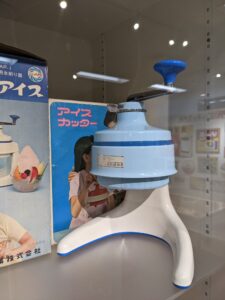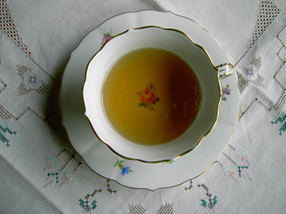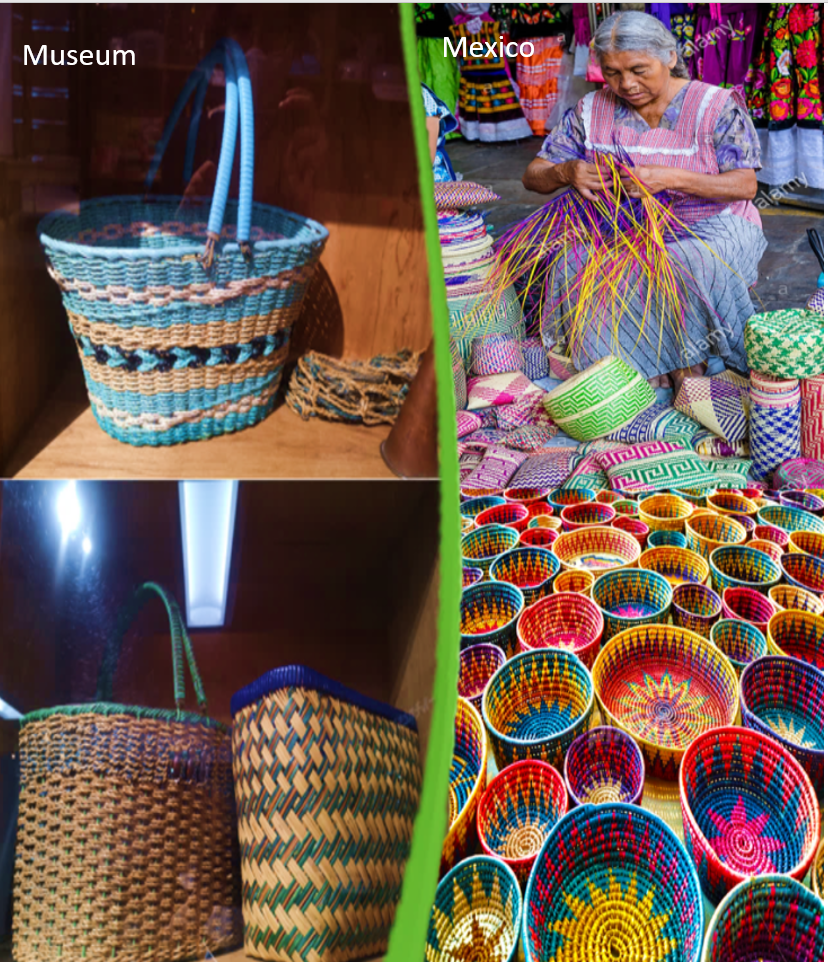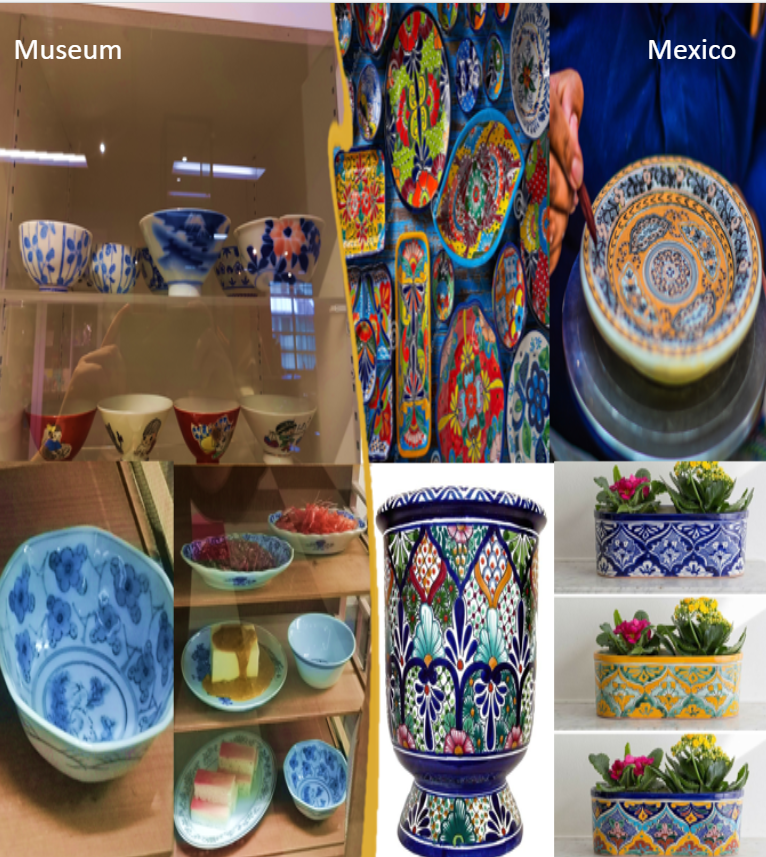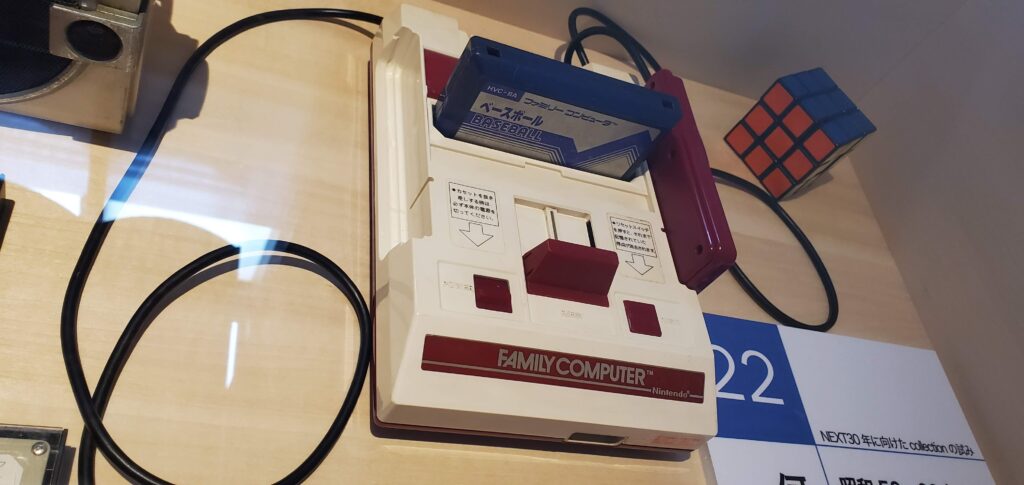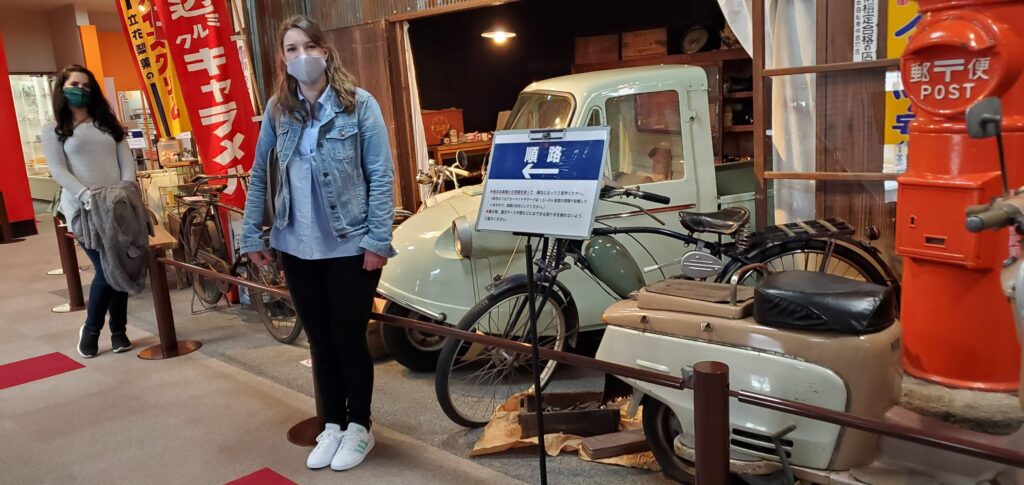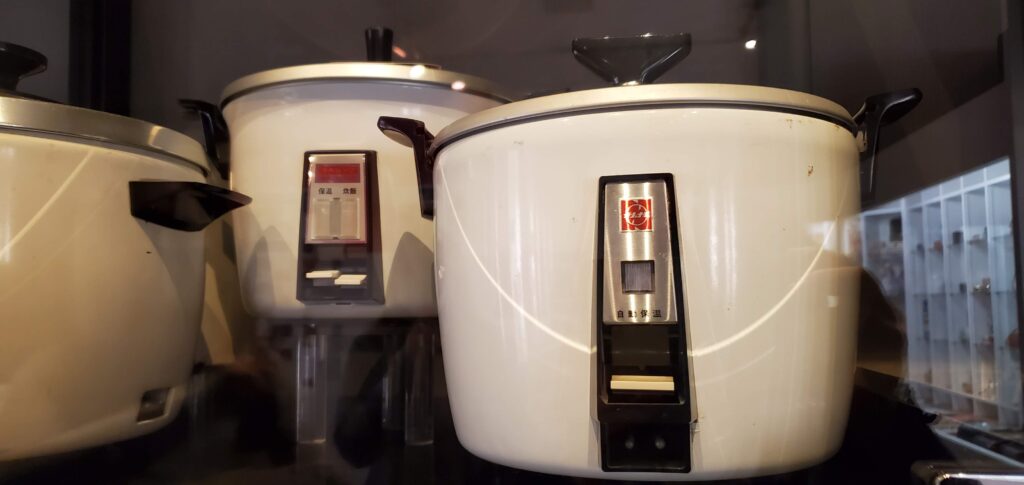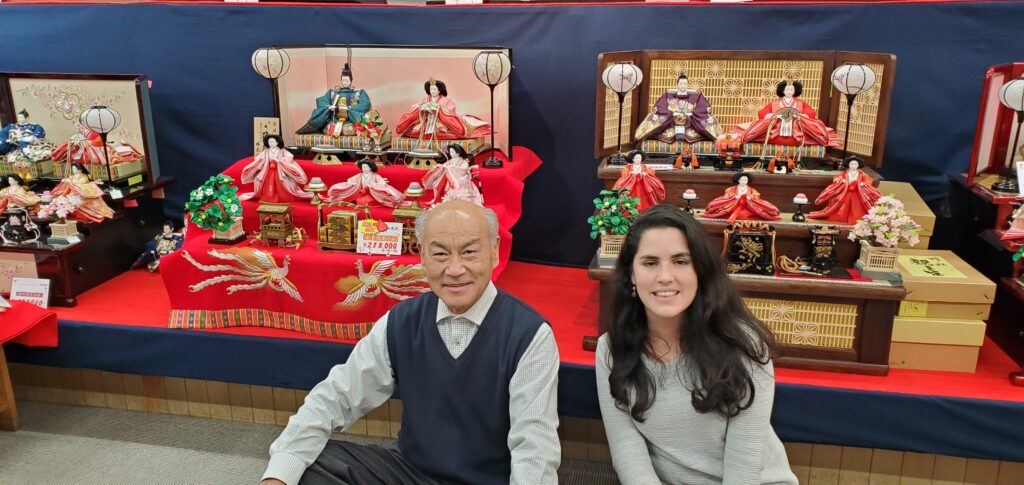This was my first time visiting the Showa Era Lifestyle Museum. It was really wonderful to be able to see aspects of a generation from the perspective of those from another country and culture. Though a bit before my time, I have a lot of fond memories of spending time with my grandparents and seeing many things similar to those in the museum. One that I found particularly nostalgic was this ice cream maker. It’s similar to the one that my grandmother had. We would spend many afternoons in the summer making ice cream. I remember the first time we tried, it ended up very salty because we didn’t make it properly. But after that, we always knew how to make lovely homemade ice cream!
 owari
owari
“Blümchenkaffee” (花ちゃんコーヒー) Sven Jensen (From Germany)
On the left the Japanese coffee cups and on the right the German coffee cup with the visible flower design through the weak coffee.
The moment I saw the beautifully ornate coffee cups, I stepped on my toes to see the bottom of the cups. To my surprise there was no adornment inside the cup, just outside. In Germany, the traditional coffee cups usually have a flower at the bottom of the cup. This is also how a humorous description of weak coffee has derived “Blümchenkaffee” (花ちゃんコーヒー). It is used when the coffee is so weak, that you can see the flower design through it.
Nowadays these cups are not that common anymore, or are used for more special occasions. Seeing these kinds of cups reminds me of being at my grandparents house over coffee and cake with the whole family.
For innovation I clearly suggest to include nostalgia to trigger emotions. People love to talk about nostalgic moments and have many stories about this to share. In an international context, this is also a wonderful opportunity to compare different cultures and see the similarities.
Perla Rodríguez Camarillo (From Mexico)
My memory about the Mexican woven baskets
When I saw these woven baskets, it reminded me of the Mexican artisans that make these baskets in the markets in Mexico. I used to see how they made it when my mother and I visit the markets during weekends. Saw this artesian is still pretty common in my country, now I wonder if I can see Japanese artisans making these beautiful woven baskets.
My memory about the “ Talavera” Mexican pottery
When I was visiting the museum I saw these beautiful cups and reminds me of Mexican pottery called “Talavera”, which can be seen not only in cups but also in floor decorations or pots for plants. I was surprised to see that they used these cups in their daily routine. In my house, the pottery is used only on special occasions like Christmas or New Year dinner. Actually, I remember that one of my favorite moments of these holidays was to finally my family and I could share some tea using the Talavera cups!
My memory of the Family Computer Samantha Young (South Africa)
Seeing the Family Computer console in the display case instantly reminded me of weekends away at my grandparents’ beach house with my family. After spending most of the day in the sun and surf, my sister and I would go inside and spend time playing games against each other or arguing over who gets to play the single player games first. Often my parents would join in the fun and play with us. Quite often our Family Computer console would stop working, and the only way to make it start again was to blow into the game cartridge and hope for the best.
My memory of our rice cooker Lucrecia Lepiz (Costa Rica)
When I came to Japan I found the rice cookers to be very modern and slick, at this museum I saw what you would consider old-style rice cookers. And guess what, it was the same one we still use in Costa Rica. These type of rice cookers are still sold in my country, so I found it very fun. In my country we start the rice cooker with some oil, garlic and onion; you fry the rice and then cook it normally. Making rice on this machine was one of the first things my mother taught me how to make at home, and I definitely burned the rice more than once.
The past 30 years to know the changes in life, the NEXT 30 years to connect

Exhibition period: – From Sunday, November 1, 2020 to Sunday, January 31st, 2021
Since its opening in 1990, Showa Era Life Museum has been engaged in various museum activities for 30 years.
In addition to the preservation and collection of materials related to the history, culture, and cultural properties of this area, which are the basis of regional museums, and research, we are actively collecting and displaying living materials that convey the changes in life in the Showa period, which is said to be a turbulent era. In the form of an exhibition, we have created a perspective that looks at the lifestyle of the Showa era from various angles.
In addition, as a measure to widely utilize the living materials of the Showa period, which have the power to stimulate people’s memories and remind them of nostalgic memories, outside the museum and in the local community, the field of elderly care was one of the first in the Japanese museum world. I have been working on the reminiscence that has been attracting attention recently. By organically linking museums, welfare, and medical care, the reminiscence method has taken root in the community, and now it goes beyond the framework of the care prevention business, and the elderly are deeply involved with the local community centered on reminiscence, and people It is developing into an activity that connects with.
At this exhibition, 30 important keywords will be used to develop the vast amount of materials and characteristic museum activities that have accumulated over the past 30 years, exceeding 100,000, in the next 30 years. I will look back and put together by extracting the collection of. Then, using the trajectory of 30 years of activity as a clue, the issues that will be required in the next 30 years, “What are the things (materials) that should be left in the future?” “What role is expected of the Showa Everyday Museum in the future?” I will think about “what?” With you.
Uchigawa Exhibition of Things
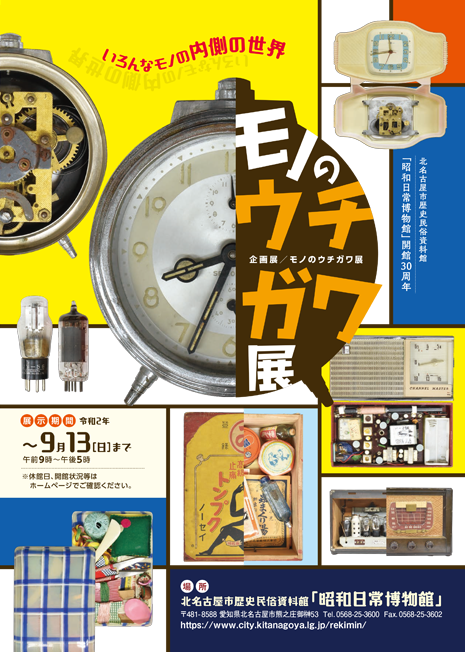
Have you ever wanted to see the inside and the back of an exhibit that you can’t see in a regular exhibition?
What’s inside the electrical appliances? What’s in that box? What was in that drawer?
To satisfy such curiosity, this time we will look inside things that cannot be seen in ordinary exhibitions.
If you look at the inside, back, and contents of things, you can see how they are used, their roles, their mechanisms, and their ingenuity.
At this exhibition, by turning the viewpoint of appreciation inward, you can take a closer look at the world that spreads inside various things, and enjoy fresh discoveries and surprises that cannot be obtained just by looking at the outside.
Introduction of the special exhibition “News Scraps that make your heart dance”
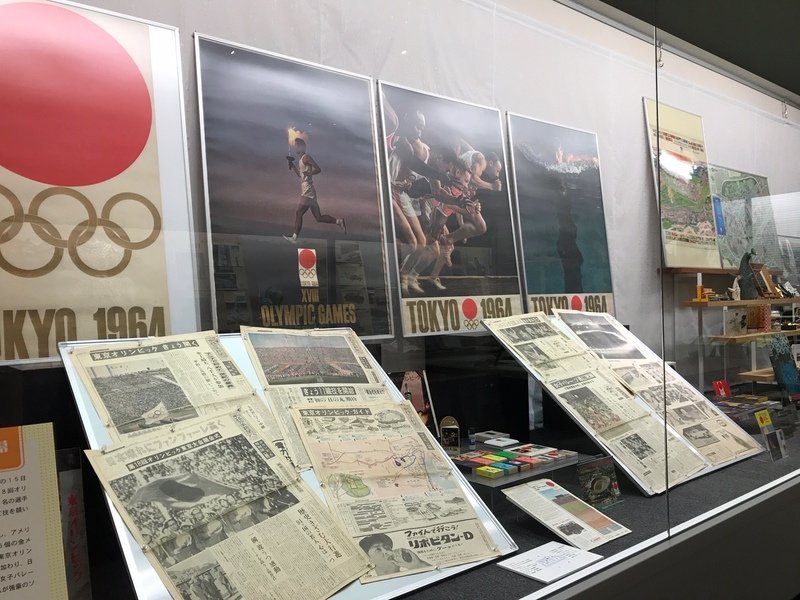
Exhibition introduction 1.
We are holding a special exhibition “News Scraps that make your heart dance”, Scrap-Events and event files of the Showa period when everyone was enthusiastic and crazy” from July 6th.
At the exhibition hall, big events and events that became social phenomena such as the Tokyo Olympics and the Osaka Expo will be exhibited together with newspaper and magazine articles that convey the news of the time and related materials, and the enthusiasm and fashion of the time It is a space where you can feel the situation.
It will be held until September 16th, so please visit the exhibition hall.
Exhibition introduction 2.
Newspapers and related materials that convey the feat of Apollo 11.

Selected as the winner of the 1st “Japanese Association of Museums Award”
Kitanagoya City Museum of History and Folklore “Showa Era Lifestyle Museum”
This award is “a system that allows up to two museums per year to be honored for their significant contributions to the promotion of Japanese museums and their outstanding achievements that serve as a model for other museums” (*).
The Chihiro Art Museum (Azumino, Tokyo) and the Kitanagoya City Museum of History and Folklore have been selected as the first award winners. The awards are scheduled to be presented at the National Museum Convention in autumn.
The reason for the award was as follows: “As a local public museum, the museum was quick to engage in projects using the reminiscence method for local elderly people, utilizing its collection of items used in daily life during the Showa era. In addition, the museum fulfills its role as an engine for passing on local culture from one person to another, and functions as a place for intergenerational exchange in the community, with a long-term vision and plan for the continuation of the project. (*).
We would like to create new approaches in the “new daily life” by seeking new ways to coexist with the prevention of the spread of COVID-19, especially by reminiscence method and being a communication-oriented museum.
(*) Japan Association of Museums, Museum Studies, Vol. 55, No. 5, 2020 “From the Japan Association of Museums: Establishment of the Japan Association of Museums Award and Selection of the First Awardees (Announcement)
2nd floor lobby / topic exhibition corner The exhibition has been changed.
September 19, 2019
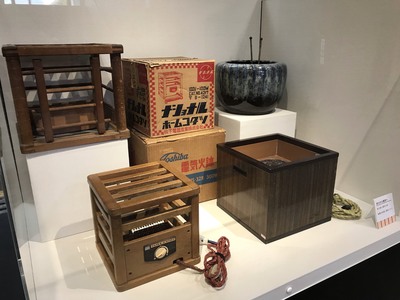
“Electrical Waves and Heating Appliances” Exhibition
The exhibition in the topic exhibition corner in the lobby on the 2nd floor has been changed.
The theme of this time is “Electrification Waves and Heating Appliances”, and we are exhibiting a collection of heating appliances around 1955, when the waves of electrification spread rapidly in our daily lives.
The photo shows a transitional electric appliance from traditional folk implements to electric appliances, in which a heater that used to use charcoal as a heat source has electrified the heat source while maintaining the basic structure and form. The left is a comparative exhibition of kotatsu and electric kotatsu, and the right is a comparative exhibition of brazier and electric brazier. _Ito

